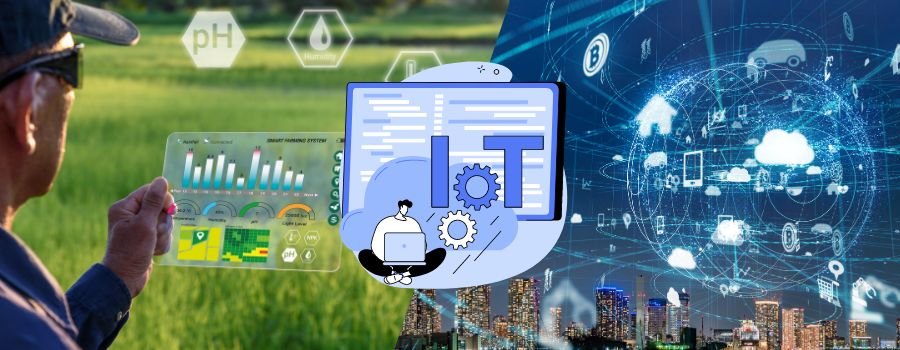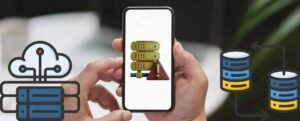The Internet of Things (IoT) technology has grown exponentially in recent years, transforming our lives, work, and interactions with the world around us. This article will review the Internet of Things, its benefits, challenges, and future potential.
What is the Internet of Things?
The Internet of Things (IoT) term has become widely popular, and it refers to the interconnected network of physical devices, vehicles, buildings, and other objects embedded with sensors, software, and connectivity capabilities. These devices can collect and exchange data, allowing them to communicate with each other and other systems, such as cloud-based applications, to enable a wide range of functions and applications.
IoT aims to create a seamless, integrated system of connected devices to improve efficiency, productivity, and convenience in various industries and applications. The devices can range from simple sensors that detect temperature or motion to complex systems that manage entire cities or supply chains. They can be used to monitor and control systems remotely, automate tasks, and gather data that can be analyzed and used to optimize operations or make informed decisions.
Advances in connectivity technologies, such as wireless networks, and the increasing availability of various low-cost sensors and devices drive the growth of IoT. The technology has applications in various industries, including healthcare, transportation, manufacturing, agriculture, and smart cities, and is expected to grow and evolve continuously as new technologies emerge. Despite the numerous benefits, challenges, such as security and privacy concerns, must be addressed as the technology expands.
Benefits of IoT
IoT can transform various industries and improve our daily lives, and it has numerous benefits in several application fields. Some of the key benefits are given below.
Increased Efficiency and Productivity
It enables real-time monitoring and automation of various processes, increasing efficiency and productivity. For instance, sensors can monitor machinery and equipment, detect malfunctions, and send alerts to the maintenance team for repairs before a breakdown occurs. This proactive approach reduces downtime and increases productivity.
Improved Decision-Making
It provides businesses with data-driven insights to help make informed decisions. Businesses can analyze trends, patterns, and anomalies with data from connected devices to better understand their operations. This information can help them optimize processes, identify areas of improvement, and make informed decisions based on real-time data.
Enhanced Customer Experience
It can allow businesses to deliver better customer experiences. For example, the devices can help companies understand customer behavior, preferences, and needs, enabling them to personalize their services or products accordingly. With IoT, companies can anticipate customer needs, respond quickly to queries, and provide better service.
Increased Safety
It can improve safety in various environments, from factories to homes. For instance, sensors can detect hazardous conditions, such as gas leaks or fires, and alert the relevant authorities. Additionally, IoT devices can monitor and control access to buildings or sensitive areas, reducing the risk of unauthorized access or theft.
Cost Savings
It can help businesses save costs by reducing waste, optimizing processes, and improving efficiency. For example, sensors can help optimize energy usage by monitoring consumption and turning off appliances when they are not in use. Additionally, IoT can help reduce maintenance costs by detecting malfunctions early, avoiding breakdowns, and reducing downtime.
Challenges of IoT
While the IoT has numerous benefits, it also poses some challenges that must be addressed. Below are some of the challenges.
Security and Privacy
The devices often collect and transmit sensitive data, such as personal information and financial details. This data is vulnerable to cyber-attacks; any breach can have severe consequences. Additionally, IoT devices may be used to spy on individuals or track their activities, raising privacy concerns. Ensuring device security and privacy is crucial to prevent breaches and building user trust.
Interoperability and Integration
The devices come from various vendors and may use different communication protocols, making integrating them into a cohesive system difficult. This interoperability issue can lead to data silos, making it challenging to gain insights from the data generated by the devices. Developing standard communication protocols and frameworks can address this challenge.
Data Management
The devices generate a massive amount of data, which can be challenging. Storing, processing, and analyzing this data requires significant computing resources and expertise. Additionally, the data generated by the devices may not be of high quality, making it challenging to derive meaningful insights. Developing robust data management strategies and tools can help address this challenge.
Scalability
IoT systems often comprise many devices and sensors, making them complex to manage and scale. Ensuring the system can handle the increasing number of devices and sensors and their interactions requires careful planning and design.
Cost
The cost of IoT devices and infrastructure can be a significant barrier to adoption, especially for small and medium-sized businesses. Additionally, the cost of maintaining and updating devices can be significant, requiring substantial investment. Finding cost-effective solutions and strategies for deployment can help address this challenge.
Future Potential of IoT
As technology advances and more devices are connected, the future potential of IoT is immense, and its impact will be significant. Some potential future applications and benefits are below.
Smart Homes
It can make our homes smarter, more efficient, and more secure. Connected devices can automate turning on lights, adjusting thermostats, and opening or closing blinds. Smart home security systems can also be connected to sensors and cameras to monitor homes remotely and alert homeowners of suspicious activity.
Predictive Maintenance
It has the potential to transform maintenance by enabling predictive maintenance. Connected devices can monitor equipment and machinery, detect malfunctions, and predict when maintenance is required, and they can reduce downtime, improve safety, and lower maintenance costs.
Supply Chain Management
IoT can enable better supply chain management by providing real-time visibility into inventory levels, shipping status, and product location. It can help businesses optimize their supply chains, reduce delays, and improve customer satisfaction.
Smart Grids
IoT can transform energy into smart grids, enabling better energy distribution and consumption management. Connected devices can monitor energy usage, predict demand, and balance supply accordingly. It can lead to reduced energy costs, improved efficiency, and a more sustainable future.
Smart Agriculture
It can enable precision farming by monitoring weather conditions, soil moisture, and crop health. It can help farmers optimize irrigation, reduce the use of pesticides and fertilizers, and increase crop yields. Additionally, IoT can enable connected livestock monitoring, providing farmers with real-time data on the health and well-being of their animals.
How are growing global IoT markets?
Allied Market Research shows that the global IoT market value was USD 740.47 billion in 2020. It is expected to reach USD 4,421.62 billion by 2030, with the market growing at a compound annual growth rate (CAGR) of 19.67% from 2021 to 2030.
Key Companies
Some prominent global IoT market players include Amazon Web Service., Cisco Systems Inc., Bosch Software Innovation Gmbh, Google Llc, Hewlett Packard Enterprise, Intel Corporation, International Business Machine Corporation (IBM), Microsoft Corporation, Oracle Corporation, and SAP SE.
Conclusion
The Internet of Things is a rapidly growing network of devices that has the potential to transform our daily life, work, and interactions with the world around us. While there are challenges to overcome, such as security and interoperability, the benefits of the technology are clear. As more devices become connected and the amount of data generated increases, the potential for innovation and improvement is enormous. The IoT is a technology that is here to stay, and its impact on our lives will continue to grow.












